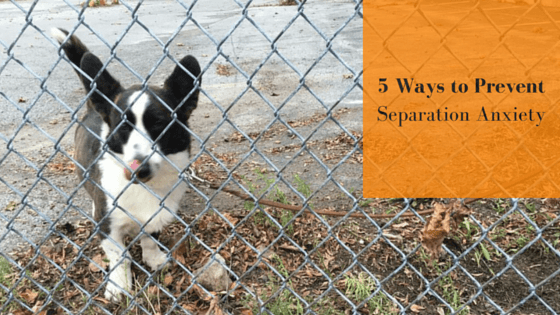
Many dog owners come to us with broken human-dog bonds. We recommend modern dog training techniques that will aid in repairing their bond while creating better behaved dogs. However, what do you do when the owner and dog have too strong of a bond and are literally inseparable?
Separation anxiety is an epidemic in the US. Dogs are injuring themselves while trying to get out of the crate or destroying homes when the owner leaves. They are angering neighbors with constant barking and living in misery and depression until their owners come home. This behavior is dangerous to their health and mental well-being and is almost entirely preventable.
Separation Anxiety Prevention Techniques
Socialization
One of the prominent triggers that can contribute to separation anxiety is under socialization. A dog who is sensitive to the sounds and smells of the outside world can startle easily if a loud sound occurs outside while you are away. Educating clients on the importance of proper socialization is an important factor in preventing separation anxiety. Socialization should teach the dog that the outside world is fun and exciting rather than scary and intimidating. Make sure your clients understand that they should not force their dogs into situations they aren’t ready for.
According to the American Veterinary Society of Animal Behavior, the critical socialization period is before the puppy hits 16 weeks of age. This means you’ll want to emphasize the need to get puppies out into the real world before they are fully vaccinated. Unfortunately, more dogs perish due to behavior issues than medical issues. Clients who wait until their puppies are fully vaccinated run the risk of behaviors issues due to under socialization in the future. In general, a puppy who is allowed to explore the outside world before 16 weeks will be more confident and less skittish as an adolescent or adult.
Crating
Encourage clients to put their dogs in crates. Every dog should learn to love being crated for practical reasons (emergencies, vet visits, travel, etc). Crating is the safest way to contain a dog while client’s are away during the day. Dogs should be crated throughout the day when the client is home and away. The most detrimental failure of crate training is putting the dog in the crate only when you leave the house. Teach clients that this should be a very happy and fun place for the dog to hangout, whether or not the clients are home, and you’ll likely change the dog’s emotional response as well.
Relaxation Exercises
The most popular train of thought I come across among clients is that you must constantly give your dog physical exercise. Their dogs grow up with plenty of daily exercise. Unfortunately, their dog adapts to the level of exercise and then the behavior problems arise due to boredom or lack of training. Relaxation exercises are incredibly important. Just like the trend with people to do meditation or yoga, relaxation is something that has to be taught to most dogs. Self control and impulse control don’t come naturally to dogs. They usually need a bit of guidance to learn how to be still and calm amidst the chaos of life these days.
Mental Stimulation Activities
Let’s face it, our clients are increasingly busy dealing with work and raising a family. Dogs don’t get as much physical or mental stimulation as they used to. Bored dogs experience more anxiety which can lead to separation anxiety. When the owner isn’t home, the dog experiences excessive boredom. One solution is to provide the dog with activities when the owner leaves. Leaving a dog to fend for itself in a crate or loose in the house is a great way to set them up to fail. Encourage owners to provide their dogs with safe chew toys, puzzles, and other activities when they leave the house.
Client’s Misdiagnosis
Clients that have a tendency to cater to their pet’s demands may fall victim to attention seeking behaviors and assume they are dealing with separation anxiety. Extinction bursts and temper tantrums can weaken a client’s intentions and make them question their methods. Ignoring a crying baby, or puppy in this case, is difficult, but important in creating an independent pup. For example, if the client begins to ignore the puppy and the puppy only barks louder, they may think the training isn’t working and tend to the puppy’s wants. Unfortunately, this creates a dog that knows how to get a reaction out of their owners. In the long run, dog that decides what he wants and knows how to get it when he wants will experience increased anxiety if his demands are not met. A consistent schedule and clear rules are important in preventing separation anxiety from the beginning.
Linda Michaels has a nice, simple article on the Positively Blog about ways you can treat and prevent separation anxiety. She discusses the importance of keeping dogs out of the bed while sleeping and providing accurate levels of stimulation to challenge dogs mentally.
What are your recommendations to new puppy owners? Share your ideas in the comments below.



